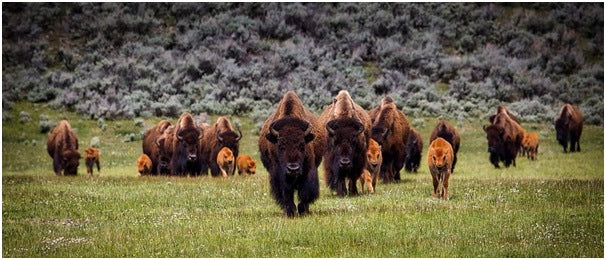
The last week of October 2021 saw some exciting, welcome news for the Chippewa Cree tribal community in Montana as 11 bison (buffalo) were returned to the tribal lands of the Rocky Boy Reservation.
Hundreds of Chippewa Cree tribal members joyfully gathered and a local drum group played as the small herd was released into a 1,200-acre pasture.
This development has been two years in the making, with The Chippewa Cree’s Buffalo Board (who will care for the bison) and Council working in partnership with the Confederated Salish Tribe (who donated six bison) and Kootenai Tribe (who donated five bison) as well as the American Prairie Reserve.
Bison and Native Identity
The Rocky Boy Reservation is home to the Chippewa Cree Tribe, and it has not had bison roaming its grounds for thirty years.
Returning these eleven bison to tribal lands is a wonderful first step in what the tribe hopes will help restore their community’s sense of identity and pride – and that as the bison flourish, so too will their tribe after what has been a very challenging time due to COVID-19 and general loss. The Chippewa Cree are hoping to expand the herd and ultimately develop a visitor center.
South Dakota Bison Release
The same week, sixty bison were also released into 28,000 acres of native grasslands of the Wolakota Buffalo Range of the South Dakota Rosebud Sioux Indian Reservation. Bison have been absent from these lands since 1880, and these animals have been brought from the Wind Cave National Park. This is the largest Native American-managed bison herd in North America. It is anticipated further releases in November 2021, as well as the birth of spring calves next year, will take the population of bison to over 1000. The land can support 1,500 and these numbers will help ensure the longevity and genetic health of the herd and the overall species.
According to the WWF Bison Program Manager Denis Jorgensen, the bison were initially wary as they were released from their holding corral but soon realized they were free to roam as far as the eye could see – and ran off in a very happy stampede.
Bison Importance
When Europeans first arrived on the North American Continent, there were between 40-60 million buffalo and as many Native Americans on the land. The animals were important to the Great Plains people for food, shelter, clothing, and ceremonial purposes, and as such, were highly revered.
As a result of European settlement and trade, as well as the appalling US government policies of the 1800s, the bison populations were decimated – having a catastrophic impact on the people who relied so heavily on them.
Returning bison to tribal lands today brings cultural renewal to Native American populations, as well as restoring the ecological balance in their native habitats.
One long-term goal is that by 2025, five herds of at least 1000 bison each are restored in the Northern Great Plains.
Support Native American Populations
There are numerous ways to support Native Americans throughout the USA – and one way is to learn about these magnificent bison and pay a visit to Native-operated, on-reservation visitor centers.
You can also offer support through shopping for gifts or for yourself at Indian Traders – purchasing Native American jewelry created by local Navajo, Hopi, and Zuni silversmiths, or by purchasing an American Indian College Fund Blanket from Pendleton.
